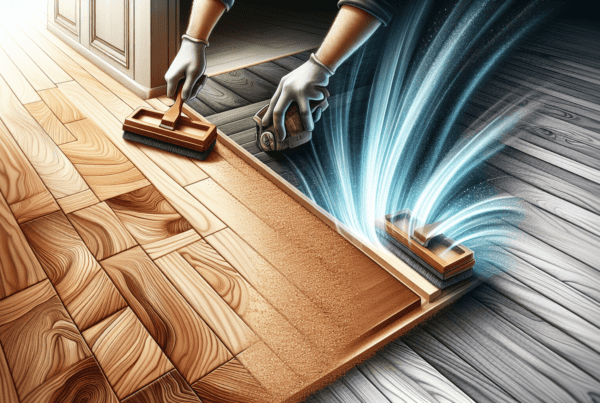In the heart of Wellington, a transformation is underway, one that brings out the hidden beauty of homes through the artistry of timber floor sanding and finishing. It’s a journey that not only revives the warmth and allure of wooden floors but also redefines spaces with an elegance that only Wellington’s finest craftsmen can achieve. Join us as we explore the meticulous process that breathes new life into timeworn floors, making them the centerpiece of any home.
Overview of Timber Floor Sanding and Finishing
Definition and importance of floor sanding and finishing
Timber floor sanding and finishing are crucial processes to renovate and protect wooden floors. Sanding removes the top layer of wood, eradicating existing finishes, blemishes, and splinters to create a smooth surface. Finishing involves applying a protective layer that enhances the wood’s natural beauty while providing resistance against wear and tear. This combination not only revives the appearance of timber floors but also extends their lifespan, making it a vital upkeep procedure for any wooden flooring.
Benefits of professional sanding and finishing for timber floors
Opting for professional services in sanding and finishing brings about precision and a quality that is hard to match through DIY methods. Professionals come equipped with the right tools and expertise, ensuring an even and smooth finish without damaging the wood. They also provide valuable advice on the best type of finish to suit the timber and usage needs, offering protection against scratches, dents, and moisture, thereby preserving the floor’s beauty and functionality for years.
Overview of the process: From sanding to sealing
The journey from sanding to sealing is methodical and detailed. It starts with the sanding process, using progressively finer grades of sandpaper to ensure the floor is perfectly smooth. After sanding, the floor is thoroughly cleaned to remove all dust and debris. Then, a finish is carefully applied, whether it be varnish, oil, or wax, depending on the desired appearance and protective qualities. The final step is sealing, which locks in the finish and provides an additional layer of protection. This meticulous process guarantees a stunning and durable outcome.
Choosing the Right Service Provider in Wellington
Factors to consider when selecting a service provider
When choosing a timber floor sanding and finishing service provider in Wellington, it’s essential to consider their experience, reputation, and the quality of their previous work. A provider with a solid record of delivering high-quality finishes showcases their competence. It’s also crucial to ensure they use professional-grade equipment and eco-friendly materials, aligning with your preferences and values.
How to verify credentials and quality of work
Verifying the credentials of a service provider involves checking their licensing, insurance, and any certifications indicating professional training or standards. Asking for a portfolio or examples of previous work allows us to assess the quality first-hand. Referrals or testimonials from past clients provide insight into their experience and satisfaction levels, offering a glimpse into what we can expect.
Importance of choosing a local Wellington service for better accountability
Selecting a local Wellington service provider extends advantages such as better accountability and easier communication. A local team is more accessible for consultations, taking measurements, and discussing project specifics. Additionally, local providers are likely to uphold a strong reputation within the community, ensuring they deliver their best work for sustained business.
Preparation Steps for Timber Floor Sanding
Clearing the room and preparing the surface
Before sanding can begin, the room must be entirely cleared of furniture and fixtures. This preparation ensures unrestricted access to the floor, reducing the risk of damage to belongings. Preparing the surface includes checking for protruding nails or defects that could harm the sanding equipment or affect the final result.
Identifying and fixing any floor damages
An essential step before sanding is to thoroughly inspect the floor for any damages, such as cracks, splits, or loose planks, and repair them accordingly. This prevents further damage during the sanding process and ensures a uniform and smooth finish. Using wood filler or replacing damaged sections might be necessary.
Cleaning the floor surface before sanding begins
Ensuring the floor is clean before sanding starts is vital to prevent dirt and debris from getting embedded in the wooden surface. A thorough vacuum and wipe-down will remove particles that could cause scratches during sanding, laying a clean foundation for the process.
The Sanding Process
Types of sanding machines used for timber floors
Professional floor sanders use a variety of machines, including belt sanders, edging sanders, and orbital sanders. Belt sanders are powerful and effective for initial sanding, removing old finishes and major imperfections quickly. Edging sanders tackle the areas close to the walls and corners, while orbital sanders are used for the final passes to ensure a uniformly smooth surface.
Step by step guide on how the sanding process works
The sanding process begins with a coarse-grit sandpaper to strip away the old finish and flatten the floor. Gradually, we move to finer grits, making each pass over the wood smoother than the last. This gradual progression ensures the timber surface is perfectly prepped for finishing, free from scratches or unevenness. The final step involves a detailed vacuuming to clear any residual dust.
Common challenges during sanding and how to overcome them
One common challenge is managing uneven floor areas, which require careful attention to avoid gouging. Using the correct grit and moving the sander evenly across the surface helps mitigate this. Dust management is another concern, which is why professional sanders come equipped with dust extraction systems to keep the area and air clean, ensuring a healthier environment and a cleaner finish.
Choosing the Right Type of Finish
Comparison between varnish, oil, and wax finishes
Varnish finishes create a durable, hard layer that is excellent for high-traffic areas, offering good protection against spills and stains. Oil finishes penetrate the wood, enhancing its natural grain and providing a more natural look while still offering protection. Wax finishes give a soft, matte look and are easy to repair, though they require more maintenance.
Factors to consider when choosing a finish (e.g., traffic, room type, aesthetic)
When selecting a finish, consider the room’s traffic level, the type of room, and the desired aesthetic. High-traffic areas benefit from the durability of varnish, while living spaces may suit the natural beauty of oil finishes. The finish should align with the room’s style, whether it’s a sleek, glossy look or a warm, matte appearance.
Benefits of eco-friendly and low VOC finishes
Eco-friendly and low VOC (volatile organic compounds) finishes are increasingly popular for their minimal environmental impact and health benefits. These finishes emit fewer harmful chemicals, improving indoor air quality and ensuring a safer environment for families and pets. They also align with sustainable living values, making them a conscientious choice for eco-minded individuals.
The Finishing Process
Application techniques for different types of finishes
The application technique varies depending on the type of finish. Varnish is typically applied with a brush or roller and requires careful handling to avoid bubbles and streaks. Oil finishes can be applied with a brush or cloth, working the oil into the wood for an even coating. Wax is often applied with a cloth, then buffed to achieve the desired sheen.
Drying times and ventilation considerations
Drying times for finishes can range from a few hours to several days, depending on the type and conditions. Adequate ventilation is crucial during and after application to ensure fumes dissipate quickly, speeding up the drying process and maintaining air quality. Always check the manufacturer’s recommendations for drying times and ventilation.
Number of coats required and the importance of curing time
The number of coats required varies, with most finishes requiring at least two for adequate protection. Each coat must be fully dried before applying the next to prevent tackiness and ensure durability. Curing time—when the finish fully hardens—is essential for achieving the final hardness and protection level, typically taking a few days to weeks.
Aftercare for Timber Floors
Daily maintenance tips to prolong floor life
Regular sweeping and vacuuming remove dirt and grit that can scratch the surface. Using felt pads under furniture prevents dents, while immediate cleaning of spills avoids water damage and stains. Avoid harsh cleaners that can strip the finish, opting for pH-neutral products designed for wood floors.
How to deal with scratches and minor damages
For minor scratches, a touch-up kit or a bit of the same finish can be applied to the affected area. Deeper scratches may require light sanding before reapplying the finish. It’s essential to address damages promptly to prevent them from worsening and affecting the wood beneath the finish.
Recommended products for cleaning and maintenance
There are specific cleaning products tailored for timber floors, depending on the finish type. These cleaners maintain the floor’s look without damaging the finish. Always use products recommended or approved by the service provider or manufacturer, as they’re formulated to work best with your floor’s finish.
Common Mistakes to Avoid in Floor Sanding and Finishing
Underestimating the value of professional equipment
Professional sanding equipment is designed to handle the demanding task of preparing and finishing floors efficiently and evenly. Attempting DIY with inferior tools can lead to subpar results, uneven surfaces, and potentially more significant damage to the floors.
Skipping necessary preparation steps
Preparation is key to a successful finish. Neglecting steps such as repairing damages, cleaning the surface, or properly vacuuming can lead to a compromised finish that might not last. Each preparatory step ensures the final finish adheres well and looks impeccable.
Applying finish unevenly or selecting the wrong type of finish
Applying finish evenly is crucial for a professional look. Uneven application can lead to patches, streaks, and an unsatisfactory overall appearance. Similarly, choosing the wrong type of finish might not provide the desired look or durability, especially in high-traffic areas or specific room types.
Case Studies: Wellington Success Stories
Detailed before and after scenarios
In one Wellington home, a well-worn, scratched, and dulled timber floor underwent a transformation. After professional sanding, the previously hidden beautiful grain of the wood came to life. An eco-friendly varnish was chosen for its durability and low VOC properties, resulting in a stunning, glossy finish that brightened the room and offered robust protection.
Client testimonials and feedback
Clients consistently praise the dramatic improvements in their floors’ appearance and the professionalism of the service. “The difference is night and day! Our floors have never looked better, and the team was efficient, tidy, and highly skilled,” shared one satisfied homeowner.
Analysis of why these projects were successful
These projects succeeded due to a combination of skilled craftsmanship, high-quality materials, and thorough preparation. Recognizing the unique needs of each floor and selecting the appropriate finish ensured a result that was not only visually appealing but also practical for the household’s needs.
Future Trends in Timber Floor Finishing
Innovations in eco-friendly materials and processes
Sustainability is becoming increasingly important, leading to innovations in eco-friendly materials that offer durability without compromising environmental values. Water-based finishes, for instance, are gaining popularity for their lower VOC content and faster drying times.
The rising popularity of matte and low-sheen finishes
Matte and low-sheen finishes are trending for their understated elegance and ability to better hide small imperfections and dust. These finishes reflect a contemporary aesthetic that values natural beauty and a more subtle, sophisticated look.
Use of advanced technologies for more durable finishes
Technological advancements are improving the durability and longevity of finishes, with nano-technology and UV-cured finishes being notable examples. These innovations promise floors that are more resistant to scratches, dents, and fading, maintaining their beauty with minimal maintenance for longer periods.
In conclusion, timber floor sanding and finishing are essential for preserving the beauty and extending the lifespan of wooden floors. By selecting the right service provider, preparing properly, understanding the processes involved, and caring for the floors post-application, homeowners in Wellington can enjoy stunning, durable timber floors that stand the test of time.







